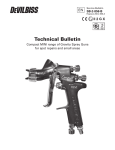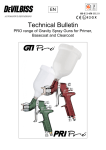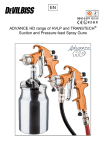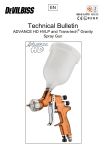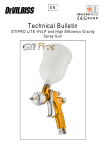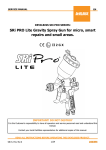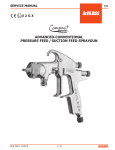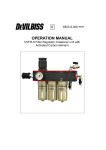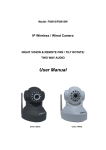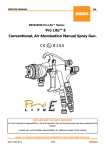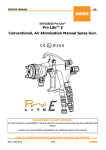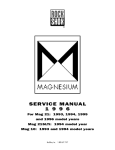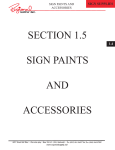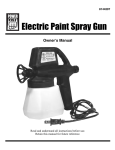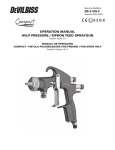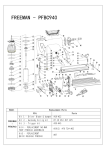Download GFG HD - Finishing Brands Europe
Transcript
EN SB-E-2-811 ISS.03 Technical Bulletin GFG HD – Gravity Spray Gun Table of Contents Topic Page EC Declaration of Conformity 3 Part Numbers 3 Operational Description 3 Kit contents 4 Construction Features 4 Materials of Construction 4 Specifications & Technical Data 4 Safety Precautions 5 Parts List 6 Exploded parts View 7 Installation, Operation, Preventive Maintenance & Cleaning 8 Parts Replacement/Maintenance 9 A. Servicing Air Valve 9 B. Replacing Air Valve 10 C. Needle Packing, Fluid Insert, Spreader Valve Assembly 11 D. Spray Head Seal 12 E. Chart 1 – Air Caps, Chart 2 – Fluid Nozzles & Fluid Needles 13 Accessories 13 Troubleshooting Possible Problems in Operation 14 Warranty 15 2 © 2008 ITW Finishing Systems and Products EC Declaration of Conformity We, ITW Finishing UK, Ringwood Rd, Bournemouth, Dorset, BH11 9LH, UK, as the manufacturer of the Spray gun model GFG-HD, declare, under our sole responsibility, that the equipment to which this document relates is in conformity with the following standards or other normative documents: BS EN 292-1 PARTS 1 & 2: 1991, BS EN 1953: 1999; and thereby conform to the protection requirements of Council Directive 98/37/EEC relating to Machinery Safety Directive, and; EN 13463-1:2001, council Directive 94/9/EC relating to Equipment and Protective Systems intended for use in Potentially Explosive Atmospheres protection level II 2 G X. B. Holt, Vice President 31st March 2008 ITW Finishing Systems and Products reserve the right to modify equipment specification without prior notice. Part Numbers The GFG HD Sprayguns are available with 2 alternative Aircaps and 3 Nozzles.C1 for base and clearcoat application. C2 is used for higher viscocity materials. The ordering code for the spray guns is; Eg, GFGPRO-C1-14 where; C1 14 = = C1 Aircap. Alternative is C2 14 Nozzle. Alternatives are 16, or 18 Operational Description This GFG HD Spray Gun is a professional quality gun designed with conventional high pressure technology. IMPORTANT: These Sprayguns are suitable for use with both waterbased and solvent based coating materials. These guns are not designed for use with highly corrosive and/or abrasive materials and if used with such materials it must be expected that the need for cleaning and/or replacement of parts will be increased. If there is any doubt regarding the suitability of a specific material, contact your DeVilbiss Distributor or DeVilbiss direct. NOTE: This gun is not to be used with halogenated hydrocarbon solvents or cleaning agents such as 1,1,1,-Trichloroethane or methylene chloride. These solvents can react with the aluminium components used in this gun and cup. The reaction can become violent and lead to an equipment explosion. © 2008 ITW Finishing Systems and Products 3 Kit contents 1 1 1 1 GFG HD Gravity Feed Spraygun GFC Gravity feed cup Cup Filter Set of 4 coloured identification rings 1 1 1 1 Spanner (10mm and 14mm A/F) Torx/Flat blade screwdriver Cleaning Brush Service bulletin Construction Features 1 2 3 4 5 6 7 8 9 Air Cap (nickel plated brass for long durability) 10 Air Cap Retaining Ring (allows easy rotation of air cap) 11 Fluid Nozzle (ideal for automotive topcoat systems) 12 Fluid Needle (grooved stem for easy removal) 13 Fluid Inlet (3/8 BSP thread – accepts DeVilbiss and most other cup systems) Air Inlet (universal thread, accepts G 1/4 & 1/4 NPS) Self Adjusting Needle Packing (for trouble free operation) Fan Air Adjustment (stepless regulation for fan to round spray) Fluid Adjustment (stepless regulation of fluid volume) Removable Spray Head (for long gun service life) 15 Interchangeable Colour ID System (4 coloured rings supplied) Anodised, forged aluminium gun body (ergonomic, good looking & durable, easy to l ) Acetal Cup (easy clean, anti-static) 500cc 16 Cup Lid with Drip Free Vent (avoid drips) 14 Trigger (ergonomic for comfort) 17 Trigger Stud & Screw (easy replacement design) 18 Air Valve (design offers low pull force & low pressure drop) Gun acceptable for waterborne and solvent borne applications Materials of Construction Gun Body Air Cap, Fluid Nozzle, Fluid Needle, Fluid Inlet, Trigger Stud Spray Head Springs, Clips, Screws Seals, Gaskets Trigger Air Inlet, Body Bushing, Spreader Valve Body, Air Valve Nut, Air Cap Retaining Ring, Knobs Air Valve Assembly Anodised aluminium Nickel plated brass Stainless steel Anodized aluminium Stainless steel Solvent resistant Chrome plated steel Chrome plated brass Stainless Steel, HPDE Specifications & Technical Data Air Supply Connection Maximum Static Air Inlet Pressure Gun Air Inlet Pressure all caps with gun triggered. Fluid Supply Connection Service Temperature Gun Weight (gun only) (with cup) Universal 1/4" BSP and 1/4" NPS male P1 = 12 bar (175 psi) See chart 1, p12 3/8" BSP 0 to 40°C (32 to 104°F) 585g 768g 4 © 2008 ITW Finishing Systems and Products SAFETY WARNINGS Fire and explosion Solvents and coating materials can be highly flammable or combustible when sprayed. ALWAYS refer to the coating material supplier’s instructions and COSHH sheets before using this equipment. Users must comply with all local and national codes of practice and insurance company requirements governing ventilation, fire precautions, operation and house-keeping of working areas. This equipment, as supplied, is NOT suitable for use with Halogenated Hydrocarbons. Static electricity can be generated by fluid and/or air passing through hoses, by the spraying process and by cleaning non-conductive parts with cloths. To prevent ignition sources from static discharges, earth continuity must be maintained to the spray gun and other metallic equipment used. It is essential to use conductive air and/or fluid hoses. Personal Protective Equipment Toxic vapours – When sprayed, certain materials may be poisonous, create irritation or be otherwise harmful to health. Always read all labels, safety data sheets and follow any recommendations for the material before spraying. If in doubt, contact your material supplier. The use of respiratory protective equipment is recommended at all times. The type of equipment must be compatible with the material being sprayed. Always wear eye protection when spraying or cleaning the spray gun. Gloves must be worn when spraying or cleaning the equipment. Training – Personnel should be given adequate training in the safe use of spraying equipment. Misuse Never aim a spray gun at any part of the body. Never exceed the maximum recommended safe working pressure for the equipment. The fitting of non-recommended or non-original spares may create hazards. Before cleaning or maintenance, all pressure must be isolated and relieved from the equipment. The product should be cleaned using a gun-washing machine. However, this equipment should not be left inside gun-washing machines for prolonged periods of time. Noise Levels The A-weighted sound level of spray guns may exceed 85 dB (A) depending on the setup being used. Details of actual noise levels are available on request. It is recommended that ear protection is worn at all times when spraying. Operating Spray equipment using high pressures may be subject to recoil forces. Under certain circumstances, such forces could result in repetitive strain injury to the operator. © 2008 ITW Finishing Systems and Products 5 PARTS LIST REF. NO. DESCRIPTION PART NO. QTY REF. NO. DESCRIPTION PART NO. QTY 1 1 Air Cap Retaining Ring - 1 31 Air Valve Cage 2 Slip Ring - 1 32 Air Valve Poppet - 3 Air Cap - 1 33 Air Valve Spring - 1 4 Air Cap Retaining Clip 1 34 Air Valve Spring Pad - 1 5 Retaining Ring Seal - 1 35 Air Valve Seal SN-34-K5 1 C1 Aircap & Ring PROC-120-C1-K 1 36 Air Valve Assembly SN-402-K 1 C2 Aircap & Ring PROC-120-C2-K 1 *37 6 JGA-156-K5 1 - 1 38 Trigger Stud Screw (T20 TORX) Trigger - 1 Trigger Stud - 1 SN-21-K 1 - 1 SN-40-K 1 SN-26-K4 1 PRO-411-K 1 7 Air Cap Retaining Ring & Seals PRO-405-K 1 *39 8 Fluid Nozzle See chart 2 p13 1 40 9 Spray Head - 1 41 Trigger, Stud & Screw Kit Plug *10 Spray Head Seal (kit of 2) SN-18-1-K2 1 42 11 Spray Head & Seal Kit SN-17-1-K 1 43 *12 Body Bushing Seal - 1 44 Air Inlet Colour ID Ring Kit (4 Colours) Airflow Valve 13 Body Bushing - 1 45 Circlip - 1 14 Body Bushing & Seal SN-6-K 1 46 Valve Head - 1 15 Fluid Needle GFGPRO-320-K 1 47 Washer - 1 *16 Needle Spring - 1 48 Valve Body - 1 *17 Needle Spring Pad - 1 49 Valve Stem - 1 18 Fluid Adjusting Knob Fluid Adjusting Knob, Spring & Pad Kit - 1 50 Baffle plate SN-41-K 1 PRO-3-K 1 51 Gravity Cup Kit GFC-501 1 2 52 Drip Check Lid (kit of 5) GFC-2-K5 1 1 53 Gravity Cup Lid GFC-402 1 2 54 Gravity Cup - 1 1 55 Filter 2 56 Air valve Service Tool 1 57 Torx Key SPN-8-K2 1 58 Stud and Screw kit SN-405-K5 1 19 - *20 Retaining Clip 21 Spreader Valve Body *22 Spreader Valve Seal 23 Spreader Valve Adjusting Knob *24 Spreader Valve Pin 25 Spreader Valve Assembly *26 Needle Packing - 1 *27 Packing Spring - 1 28 Packing Nut - 1 29 Packing, Spring & Packing Nut Kit 30 Air Valve Body PRO-402-K SN-404-K 1 - KGP-5-K5 - 1 1 SERVICE PARTS Spray Gun repair kit (includes PRO-415-1 items marked *) Seal and Pin Kit, kit of 5 GTI-428-K5 (items 20, 22 and 24) For accessories, see page 13 6 © 2008 ITW Finishing Systems and Products © 2008 ITW Finishing Systems and Products 7 INSTALLATION broom straw or toothpick if possible. If a wire or hard instrument is used, extreme care must be used to prevent scratching or burring of the holes which will cause a distorted spray pattern. For maximum transfer efficiency, do not use more pressure than is necessary to atomise the material being applied. 1. 2. Connect the gun to a clean, moisture and oil free air supply using a conductive hose, of at least 8 mm I.D. NOTE Depending on hose length, larger I.D. hose may be required. Install an air gauge at the gun handle. When gun is triggered on, adjust regulated air pressure to the required setting (see chart 1 p12). Do not use more pressure than is necessary to atomise the material being applied. Excess pressure will create additional overspray and reduce transfer efficiency. NOTE If an air adjusting valve is used at the gun inlet, use DGI-501-bar Digital Gauge. Some competitive adjusting valves have significant pressure drop that can adversely affect spray performance. The DGI Digital Gauge has minimal pressure drop. Attach the gravity feed cup to the material inlet. NOTE Before using the gun, flush it with solvent to ensure that the fluid passages are clean. OPERATION 1. 2. 3. 4. 5. 6. 7. 8. 9. 10. 11. 12. 13. 14. Mix coating material to manufacturer’s instructions and strain material. Fill the cup to no more than 20 mm from the top of the cup. DO NOT OVERFILL. Attach Cup Lid. Turn fluid adjusting knob (18) clockwise to prevent fluid needle movement. Turn spreader valve adjusting knob (23) counter clockwise to fully open. Adjust inlet air pressure (see chart 1 p12). Turn fluid adjusting knob counter clockwise until first thread shows. Test spray. If the finish is too dry, reduce airflow by reducing air inlet pressure. If finish is too wet, reduce fluid flow by turning fluid adjusting knob (18) clockwise. If atomisation is too coarse, increase inlet air pressure. If too fine, reduce inlet pressure. The pattern size can be reduced by turning spreader valve knob (23) clockwise. Hold gun perpendicular to surface being sprayed. Arcing or tilting may result in uneven coating. The recommended spray distance is 150-200 mm. Spray edges first. Overlap each stroke a minimum of 75%. Move gun at a constant speed. Always turn off air supply and relieve pressure when gun is not in use. To clean fluid passages, remove excess material from cup, then flush with gun wash solution. Wipe the gun exterior with a dampened cloth. Never completely immerse in any solvent as this is detrimental to the lubricants and life of the spray gun. NOTE When replacing the fluid nozzle or fluid needle, replace both at the same time. Using worn parts can cause fluid leakage. See page 13, Chart 2. Also, replace the needle packing at this time. Torque the fluid nozzle to 14–16 nm. Do not over tighten. CAUTION To prevent damage to fluid nozzle (8) or fluid needle (15), be sure to either 1) pull the trigger and hold while tightening or loosening the fluid nozzle, or 2) remove fluid adjusting knob (18) to relieve spring pressure against needle collar. CAUTION IMPORTANT– the Gravity cup is made from special antistatic materials, but it still important to avoid generating static charges. The Cup must not be cleaned or rubbed with a dry cloth or paper. It is possible to generate a static charge by rubbing which, if discharged to an earthed object could create an incendive spark and cause solvent vapours to ignite. Only use a dampened cloth or antistatic wipes if manual cleaning is required within a hazardous area. PREVENTIVE MAINTENANCE & CLEANING To clean air cap and fluid nozzle, brush exterior with a stiff bristle brush. If necessary to clean cap holes, use a 8 © 2008 ITW Finishing Systems and Products Parts Replacement/Maintenance AIR VALVE INSTRUCTIONS Servicing Air Valve Reasons to service air valve: A) Air valve not functioning correctly (may need cleaning). B) Routine maintenance. C) Air leaks (advise replacement, see p10) 1. Remove trigger using the tool supplied (SPN-8) or TORX T20 key. (See fig 1 & 2) 2. Unscrew air valve using SN-28 (14 mm) spanner. (See fig 3) 3. Remove air valve by gripping stem. (See fig 4) 4. Remove spring with spring pad. (See fig 5) 5. DO NOT REMOVE REAR SEAL (35) FROM GUN BODY. (See fig 6) 6. DO NOT REMOVE PLASTIC CAGE FROM AIR VALVE BODY AS THIS MAY DAMAGE THE CAGE. (See fig 7) 7. CLEAN a. Remove all paint build up. (See fig 8) b. The 4 poppet holes must be clear. (See fig 9) c. Stem must be free to float in poppet. (See fig 10) d. Stem must slide through cage bore with slight resistance (due to seal). e. Rear seal must look clean and in position in the bore. (See fig 6) f. If any of the above cannot be rectified, replace the air valve (See Replacing Air Valve p10). 8. Replace spring ensuring the end with the plastic bearing pad goes in first. (See fig 5) 9. Insert air valve assembly into gun and carefully feed over the spring and through the rear seal. (See fig 11) 10. Tighten air valve assembly using fingers first, and then tighten with SN-28 (14mm) Spanner. (See figs 12 & 3) 11. Replace trigger. (See figs 2 & 1) 12. If there is an air leak through the gun, the air valve may need replacing (See Replacing Air Valve). © 2008 ITW Finishing Systems and Products 9 Replacing Air Valve Reasons to replace air valve: A) Air leak through the gun. B) Air valve not operating correctly. 1. Remove trigger using SPN-8 or TORX (T20) key provided in the kit. (See figs 13 & 14) 2. Unscrew air valve using SN-28 (14 mm) Spanner. (See fig 15) 3. Remove air valve by gripping the stem. (See fig 16) 4. Remove spring with spring pad. (See fig 17) 5. Hook out rear seal using Service Tool (56). (See figs 18 & 19) 6. Clean air valve bores in gun body with the brush supplied in the kit. 7. Place new rear seal onto Service tool (56); grooves must fit in service tool form. (See fig 20) 8. Push rear seal firmly into hole up to shoulder, using Service tool. (See figs 21 & 22) 9. Insert new spring, ensuring the end with the plastic bearing pad goes in first. (See fig 17) 10. Insert air valve assembly into gun and carefully feed over the spring and through the rear seal. (See fig 23) 11. Tighten air valve assembly using fingers first, then tighten with SN-28 (14 mm) Spanner. (See figs 24 & 15) 12. Replace trigger. (See figs 14 & 13) 10 © 2008 ITW Finishing Systems and Products Parts Replacement/Maintenance NEEDLE PACKING REPLACEMENT INSTRUCTIONS 13. Remove trigger using SPN-8 or TORX (T20) driver. (See figs 25 & 26) 14. Remove fluid adjusting knob and needle spring with spring pad from gun. (See figs 27 & 28) 15. Remove fluid needle from gun body. (See fig 29) 16. Loosen and remove packing nut using SPN-8 Key or a straight blade screwdriver. (See figs 30 & 31) 17. Discard old packing and packing spring if replacing. Clean packing if reusing. Also clean packing spring and nut. (See fig 32). 18. Re-assemble the packing, (See fig 32). Assemble into gunbody by hand (see fig 33) and then tighten. (See figs 30 and 31) 19. Insert fluid needle all the way into gun body seating in fluid nozzle (See fig 34). 20. Insert needle spring, spring pad, and fluid adjusting knob. (See figs 28 & 27). Reinstall trigger. (See figs 25 & 26). 21. Trigger gun fully and screw in fluid adjusting knob until it stops. Back it off 1/2 turn and gun will have full needle travel. 22. Trigger gun several times to verify correct operation. FLUID SUPPLY INSERT The fluid insert and seal are NOT replaceable. Do not remove these parts. No maintenance is required for these parts other than regular cleaning. SPREADER VALVE ASSEMBLY REPLACEMENT/MAINTENANCE The spreader valve assembly can be replaced if damaged. Remove using SN-28 (14 mm) Spanner (See figs 35 & 36). The internal seal can be replaced and is included in the PRO-415-1 Gun Rebuild Kit. © 2008 ITW Finishing Systems and Products 11 Parts Replacement/ Maintenance SPRAY HEAD SEAL REPLACEMENT 1. Remove air cap and retaining ring. (See fig 37) 2. Remove fluid adjusting knob, spring, and spring pad. (See figs 38 & 39) 3. Remove fluid needle from gun body. (See fig 40) 4. Remove fluid nozzle using SN-28 (10 mm) ring Spanner, and the Front Plate. (See figs 41, 42 & 43) 5. Remove Spray Head. (See fig 44). 6. Clean Spray Head with a soft brush (See fig 45). 7. Remove Spray Head seal using a small screwdriver or pick. (See fig 46) 8. Clean front of gun if required, using a soft brush, as well as the Spray Head, fluid nozzle, air cap, and retaining ring. (See fig 47) 9. Place a new Spray Head Seal onto the front of the gun, making sure the flat on the seal is aligned with the flat in the gun. (See fig 48). 10. Fit the Front Plate onto the Spray Head, fit Spray Head to the Gunbody, ensuring the flat on the underside of the Spray Head locates with the flat in the Gun Body. Fit Fluid Nozzle, Air Cap, and Retaining Ring. Torque the Fluid Nozzle to 14–16 nm. Don’t over torque the fluid nozzle. (See figs 44, 43, 42, 41 and 37) 11. Insert Fluid Needle all the way into the Gun Body, seating in the Fluid Nozzle. (See fig 40) 12. Reassemble Needle Spring, Spring Pad, and Fluid adjusting Knob. (See figs 39 & 38) 13. Trigger gun fully and screw in Fluid Adjusting Knob until it stops. Back it off 1/2 turn and gun will have full needle travel. 14. Trigger gun several times to verify correct operation. 12 © 2008 ITW Finishing Systems and Products Parts Replacement/Maintenance Chart 1 – Air Caps TECHNOLOGY MARKING ON AIR CAP PROC-120-C1-K CONVENTIONAL PROC-120-C2-K CONVENTIONAL PART No. FOR AIR CAP C1 RECOMMENDED INLET PRESSURE (bar) 2.5 – 3.0 AIR FLOW (L/min) 250 - 300 C2 2.5 - 4.0 255 - 400 NOTE: When removing air cap from retaining ring, don’t remove the Slip Ring (2) or Retaining Ring Seal (5) from the Retaining Ring. Damage to the parts may occur. Slip ring and Retaining Ring seal are not available as replacements. Simply wipe parts clean and reassemble with new or clean air cap. Chart 2 – Fluid Nozzle Range & Fluid Needle PART No. ON FLUID NOZZLE PART No. NEEDLE PROC-220-14-K GFGHD-320-K PROC-220-16-K PROC-220-18-K NOTE: When replacing the fluid nozzle or fluid needle, replace both at the same time. Torque to 18–20 nm (13–15 ftlbs). Don’t over tighten the fluid nozzle. Use SN-28 10mm Spanner supplied with the gun and check with a torque wrench. ACCESSORIES DGi Digital Pressure Gauge DGI-501-BAR Gun Stand GFV-50-F Spanner SN-28-K MC-1-K50 600 cc Mixing Cups pack of 50 Torx driver SPN-8-K2 10m x 8mm bore rubber air hose with ¼ fittings H-6065-B (BSP) H-6065-N (NPS) MPV Swivel MPV-60-K3 Pack of four QD fittings MPV-463 Cleaning Brush 4900-5-1-K3 © 2008 ITW Finishing Systems and Products 13 Troubleshooting Possible Problems in Operation CONDITION CAUSE CORRECTION Heavy top or bottom pattern Horn holes plugged. Clean. Ream with non-metallic point. Obstruction on top or bottom of fluid nozzle. Cap and/or nozzle seat dirty. Left or right side horn holes plugged. Dirt on left or right side of fluid nozzle. Clean. Clean. Clean. Ream with non-metallic point. Clean. Heavy right or left side pattern Remedies for the top-heavy, bottom-heavy, right-heavy, and left-heavy patterns: 1. Determine if the obstruction is on the air cap or the fluid nozzle. Do this by making a test spray pattern. Then, rotate the cap one-half turn and spray another pattern. If the defect is inverted, obstruction is on the air cap. Clean the air cap as previously instructed. Also check for dried paint just inside the cap center hole opening; remove by washing with solvent. 2. If the defect is not inverted, it is on the fluid nozzle. Clean nozzle. If problem persists, renew nozzle. Heavy centre pattern Split spray pattern Spreader adjustment valve set too low. Turn out counter clockwise to achieve correct pattern. Atomising pressure too low. Increase pressure. Material too thick. Thin to correct consistency. Air pressure too high. Reduce at regulator or gun handle. Fluid adjusting knob turned in too far. Turn out counter clockwise to achieve correct pattern. Spreader adjusting valve set too high. Jerky or fluttering spray Paint bubbles in cup Fluid leaking or dripping from cup lid Turn in clockwise to achieve correct pattern. Loose or damaged fluid nozzle/seat Tighten or replace Loose or broken cup fluid nipple Tighten or replace cup Material level too low Refill Container tipped too far Hold more upright Obstruction in fluid passage Back flush with solvent Loose fluid needle packing nut Tighten Damaged fluid needle packing Replace Fluid nozzle not tight. Cup lid loose. Fluid nozzle not tight. Tighten to 14– 16 nm (10-12 ft-lbs). Push in or replace. Dirty cup or lid. Clean. Cracked cup or lid. Replace cup and lid. 14 © 2008 ITW Finishing Systems and Products Troubleshooting Possible Problems in Operation (cont) Starved spray pattern Excessive overspray Dry spray Fluid leaking from packing nut Fluid leaking or dripping from front of gun Fluid dripping or leaking from bottom of cup Runs and sags © 2008 ITW Finishing Systems and Products Inadequate material flow Wind fluid adjusting knob out or change to larger fluid nozzle size Blocked vent in Cup lid Clean lid and unblock vent Low atomisation air pressure Increase air pressure and rebalance gun. Air pressure to high. Reduce air pressure. Gun too far from work surface. Adjust to correct distance. Air pressure too high. Reduce air pressure. Gun too far from work surface. Adjust to correct distance. Gun motion too fast. Slow down. Fluid flow too low. Wind out needle adjusting screw or use larger nozzle size. Packing worn. Replace. Fluid nozzle or fluid needle worn or damaged. Replace fluid nozzle and fluid needle. Foreign matter in fluid nozzle. Clean. Fluid needle dirty or stuck in needle packing Clean Wrong size fluid needle or fluid nozzle. Replace fluid nozzle and fluid needle. Cup loose on gun. Tighten Cup fluid inlet seat dirty. Clean. Too much material flow. Turn fluid adjusting knob clockwise or switch to smaller fluid nozzle and fluid needle size. Material too thin. Mix correctly or apply light coats. Gun tilted on an angle, or gun motion too slow. Hold gun at right angle to work and adapt to correct gun technique. 15 WARRANTY This product is covered by ITW Finishing Systems and Products Limited one year warranty. ITW Finishing Systems and Products Ringwood Road, Bournemouth, BH11 9LH, UK Tel. No. (01202) 571111 Telefax No. (01202) 581940, Website address http://www.infoifeuro.com ITW Finishing Systems and Products is a Division of ITW Ltd. Reg. Office: Admiral House, St Leonard’s Road, Windsor, Berkshire,SL4 3BL,UK. Registered in England: No 559693 Vat No 619 5461 24 16 © 2008 ITW Finishing Systems and Products
















